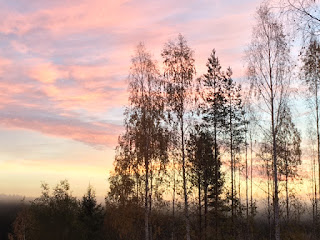On my way to Madrid!
 It’s already autumn and the course in Madrid is almost
there! It is time to orientate to “London” language and get used to Spanish culture
and schedules. Long days coming in Madrid next week! I have read only two
articles and still few to come. The issue is very interesting in the course;
Functional recovery of the upper limb and hand.
It’s already autumn and the course in Madrid is almost
there! It is time to orientate to “London” language and get used to Spanish culture
and schedules. Long days coming in Madrid next week! I have read only two
articles and still few to come. The issue is very interesting in the course;
Functional recovery of the upper limb and hand.
The course is organized by Ibita the International
Bobath Instructors Training Association. The course instructor is Mary
Lynch-Ellerington and she is assisted by Miguel Benito Garcia, basic course
instructor. The course is in rehabilitation center Centro Lescer, in Madrid.
We have four articles to read before the course. The
first article I’ve read was about the recovery of the upper limb and hand from
the stroke survivors perspective. It was qualitative study, which was made in
Australia to survivors (19) and their spouses (9). This study gives very
valuable information for us, therapists, about stroke survivors thoughts and
their personal experiences.
There has been shown that upper limb training
programmes involving intensive and repetitive task related practices improve
recovery. Anyway, recovery in hospitals is mainly teaching only how to walk
before you get back home. It is also financial question, but this diminishes
the recovery training of upper limb. One participant said in the interview: “It would almost be easier if the arms came
back. You could sit in a wheelchair, at least you could do something. When the
leg comes back the only thing you learn to do is walk. But the number of things
you can do with an arm…”
The results of this study, some kind of survivors
processes how to manage and survive:
 “Keeping the
door open”, “Even years later things
are still changing as long as you haven’t accepted this is all over”. Survivors
don’t want time limits for recovery or that someone says what is possible or
not.
“Keeping the
door open”, “Even years later things
are still changing as long as you haven’t accepted this is all over”. Survivors
don’t want time limits for recovery or that someone says what is possible or
not.
“Hanging in
there”, “You have to take
responsibility for yourself, you have got to work at it. Don’t ever give up.” Personal
commitment is required and not to give up.
“Drawing on
support”, ..The courage the
physiotherapist gave me is what I needed. That he had faith in me.” The
participants believed that the support from others (spouses, friends, therapists etc.) was remarkable for them to
achieve a good recovery of their arm.
“Getting going
and keeping going with exercise”, “If you sit in a chair and do nothing you
definetily won’t improve.” Exercise was seen as the means to physical recovery.
Participants emphasized that it was important to start soon after onset,
practicing regularly, intensively, appropriately and continually, using the arm
in every day tasks.
 Today I had a short discussion with my ”stroke survivor”
about the topic and he agreed the results. It is far more interesting to do and
work with your both hands than learn how to walk again. He has ”survived”
pretty well in 1,5 years since his stroke. He can walk with small stick or even
without any aid and in the last half of the year he has learned to use his more
affected arm in grasping and reaching on his shoulder level. He said the arm
was forgotten in the early stages in recovery, but gladly his wife had an
instinct how “to keep the door open”. She helped to stimulate the sensory from
the fingers and the arm and held the possibility to regain the good recovery of
the arm. He also thinks this is a journey and a lifetime project, not just a
one year sprint!
Today I had a short discussion with my ”stroke survivor”
about the topic and he agreed the results. It is far more interesting to do and
work with your both hands than learn how to walk again. He has ”survived”
pretty well in 1,5 years since his stroke. He can walk with small stick or even
without any aid and in the last half of the year he has learned to use his more
affected arm in grasping and reaching on his shoulder level. He said the arm
was forgotten in the early stages in recovery, but gladly his wife had an
instinct how “to keep the door open”. She helped to stimulate the sensory from
the fingers and the arm and held the possibility to regain the good recovery of
the arm. He also thinks this is a journey and a lifetime project, not just a
one year sprint!
So, keep on going and don't forget the arm, even in the early stages!
TAB
Reference: R.N.Barker & S.G.Brauer, 2009 Disability and Rehabilitation; Upper limb recovery after stroke: stroke survivors perspective






Hola y felicidades por el post, me ha conmovido
VastaaPoistaSaludos
Gracias!
Poista